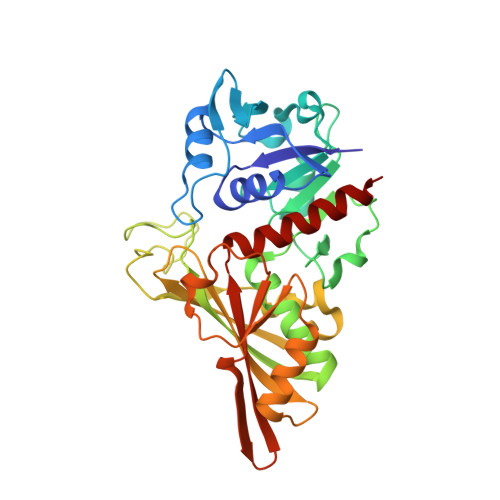The Antimicrobials Anacardic Acid and Curcumin Are Not-Competitive Inhibitors of Gram-Positive Bacterial Pathogenic Glyceraldehyde-3-Phosphate Dehydrogenase by a Mechanism Unrelated to Human C5a Anaphylatoxin Binding.
Gomez, S., Querol-Garcia, J., Sanchez-Barron, G., Subias, M., Gonzalez-Alsina, A., Franco-Hidalgo, V., Alberti, S., Rodriguez de Cordoba, S., Fernandez, F.J., Vega, M.C.(2019) Front Microbiol 10: 326-326
- PubMed: 30863383
- DOI: https://doi.org/10.3389/fmicb.2019.00326
- Primary Citation of Related Structures:
6FZH, 6FZI - PubMed Abstract:
The ubiquitous and highly abundant glycolytic enzyme D-glyceraldehyde-3-phosphate dehydrogenase (GAPDH) is pivotal for the energy and carbon metabolism of most organisms, including human pathogenic bacteria. For bacteria that depend mostly on glycolysis for survival, GAPDH is an attractive target for inhibitor discovery. The availability of high-resolution structures of GAPDH from various pathogenic bacteria is central to the discovery of new antibacterial compounds. We have determined the X-ray crystal structures of two new GAPDH enzymes from Gram-positive bacterial pathogens, Streptococcus pyogenes and Clostridium perfringens . These two structures, and the recent structure of Atopobium vaginae GAPDH, reveal details in the active site that can be exploited for the design of novel inhibitors based on naturally occurring molecules. Two such molecules, anacardic acid and curcumin, have been found to counter bacterial infection in clinical settings, although the cellular targets responsible for their antimicrobial properties remain unknown. We show that both anacardic acid and curcumin inhibit GAPDH from two bacterial pathogens through uncompetitive and non-competitive mechanisms, suggesting GAPDH as a relevant pharmaceutical target for antibacterial development. Inhibition of GAPDH by anacardic acid and curcumin seems to be unrelated to the immune evasion function of pathogenic bacterial GAPDH, since neither natural compound interfere with binding to the human C5a anaphylatoxin.
Organizational Affiliation:
Center for Biological Research, Spanish National Research Council, Madrid, Spain.

















